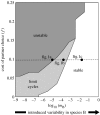Cheating can stabilize cooperation in mutualisms
- PMID: 16901844
- PMCID: PMC1635526
- DOI: 10.1098/rspb.2006.3571
Cheating can stabilize cooperation in mutualisms
Abstract
Mutualisms present a challenge for evolutionary theory. How is cooperation maintained in the face of selection for selfishness and cheating? Both theory and data suggest that partner choice, where one species preferentially directs aid to the more cooperative members of the other species, is central to cooperation in many mutualisms. However, the theory has only so far considered the evolutionary effects of partner choice on one of the species in a mutualism in isolation. Here, we investigate the co-evolution of cooperation and choice in a choosy host and its symbiont. Our model reveals that even though choice and cooperation may be initially selected, it will often be unstable. This is because choice reduces variation in the symbiont and, therefore, tends to remove the selective incentive for its own maintenance (a scenario paralleled in the lek paradox in female choice and policing in within-species cooperation). However, we also show that when variability is reintroduced into symbionts each generation, in the form of less cooperative individuals, choice is maintained. This suggests that the presence of cheaters and cheater species in many mutualisms is central to the maintenance of partner choice and, paradoxically, cooperation itself.
Figures



Similar articles
-
Rethinking mutualism stability: cheaters and the evolution of sanctions.Q Rev Biol. 2013 Dec;88(4):269-95. doi: 10.1086/673757. Q Rev Biol. 2013. PMID: 24552098 Review.
-
Evolutionary stability of one-to-many mutualisms.J Theor Biol. 2012 Dec 7;314:138-44. doi: 10.1016/j.jtbi.2012.08.037. Epub 2012 Sep 7. J Theor Biol. 2012. PMID: 22974562
-
The evolution of mutualism.J Evol Biol. 2010 Dec;23(12):2507-28. doi: 10.1111/j.1420-9101.2010.02114.x. Epub 2010 Oct 13. J Evol Biol. 2010. PMID: 20942825 Review.
-
Economic contract theory tests models of mutualism.Proc Natl Acad Sci U S A. 2010 Sep 7;107(36):15712-6. doi: 10.1073/pnas.1005294107. Epub 2010 Aug 23. Proc Natl Acad Sci U S A. 2010. PMID: 20733067 Free PMC article.
-
Kin selection-mutation balance: a model for the origin, maintenance, and consequences of social cheating.Am Nat. 2011 Mar;177(3):288-300. doi: 10.1086/658365. Am Nat. 2011. PMID: 21460538
Cited by
-
When cheating turns into a stabilizing mechanism of plant-pollinator communities.PLoS Biol. 2023 Dec 27;21(12):e3002434. doi: 10.1371/journal.pbio.3002434. eCollection 2023 Dec. PLoS Biol. 2023. PMID: 38150463 Free PMC article.
-
Carbon allocation and competition maintain variation in plant root mutualisms.Ecol Evol. 2018 May 4;8(11):5792-5800. doi: 10.1002/ece3.4118. eCollection 2018 Jun. Ecol Evol. 2018. PMID: 29938093 Free PMC article.
-
Evolution of microbial markets.Proc Natl Acad Sci U S A. 2014 Jan 28;111(4):1237-44. doi: 10.1073/pnas.1315980111. Epub 2014 Jan 13. Proc Natl Acad Sci U S A. 2014. PMID: 24474743 Free PMC article.
-
Variation and the response to variation as a basis for successful cooperation.Philos Trans R Soc Lond B Biol Sci. 2010 Sep 12;365(1553):2627-33. doi: 10.1098/rstb.2010.0159. Philos Trans R Soc Lond B Biol Sci. 2010. PMID: 20679107 Free PMC article. Review.
-
Evolution of self-limited cell division of symbionts.Proc Biol Sci. 2019 Jan 30;286(1895):20182238. doi: 10.1098/rspb.2018.2238. Proc Biol Sci. 2019. PMID: 30963950 Free PMC article.
References
-
- Bao T, Addicott J.F. Cheating in mutualism: defection of Yucca baccata against its yucca moths. Ecol. Lett. 1998;1:155–159. doi:10.1046/j.1461-0248.1998.00032.x - DOI
-
- Barton N.H, Keightley P.D. Understanding quantitative genetic variation. Nat. Rev. Genet. 2002;3:11–21. doi:10.1038/nrg700 - DOI - PubMed
-
- Bronstein J.L. The scope for exploitation within mutualistic interactions. In: Hammerstein P, editor. Genetic and cultural evolution of cooperation. MIT Press; Cambridge, MA: 2003. pp. 185–202.
-
- Bshary R, Grutter A.S. Asymmetric cheating opportunities and partner control in a cleaner fish mutualism. Anim. Behav. 2002;63:547–555. doi:10.1006/anbe.2001.1937 - DOI
-
- Bull J.J, Rice W.R. Distinguishing mechanisms for the evolution of co-operation. J. Theor. Biol. 1991;149:63–74. - PubMed
Publication types
MeSH terms
LinkOut - more resources
Full Text Sources

